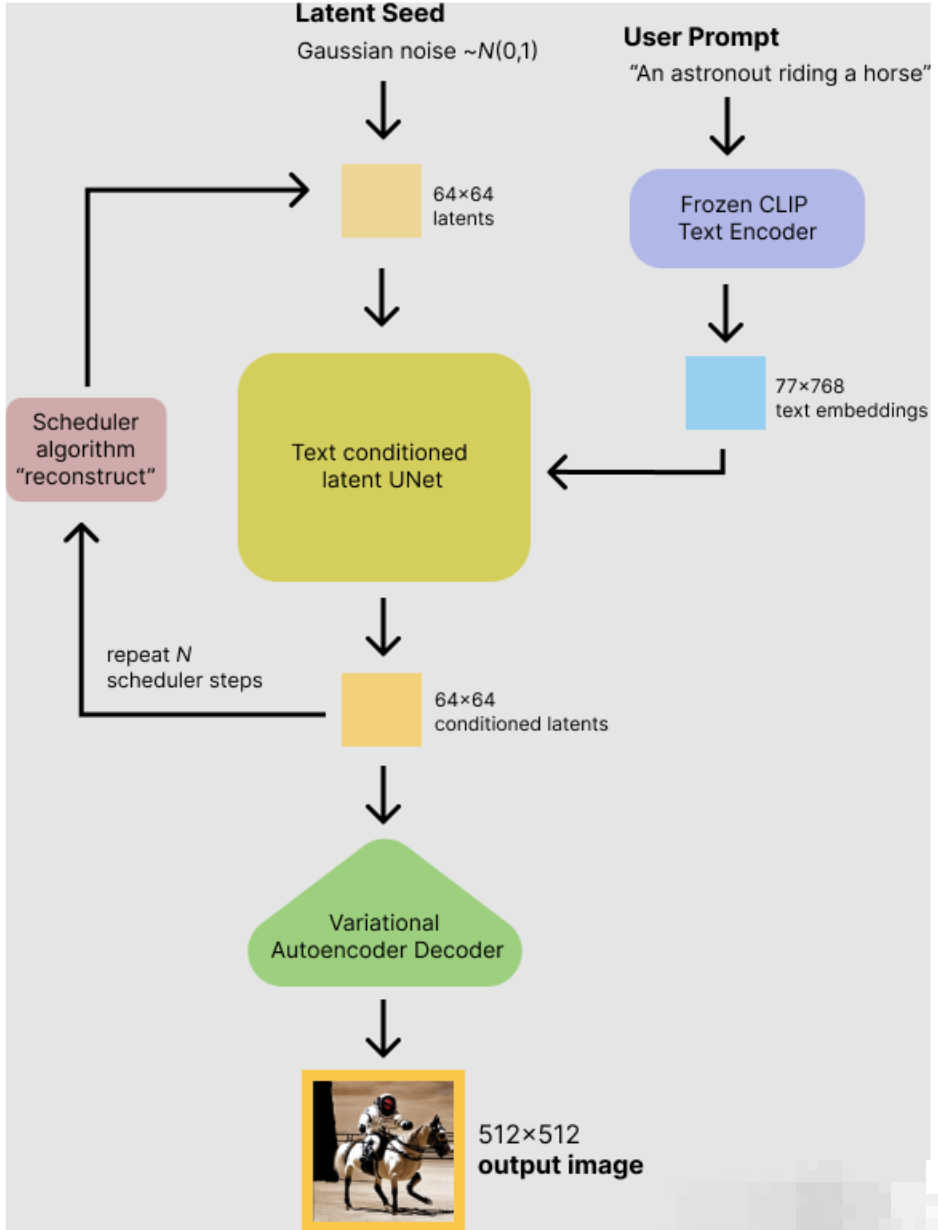1
2
3
4
5
6
7
8
9
10
11
12
13
14
15
16
17
18
19
20
21
22
23
24
25
26
27
28
29
30
31
32
33
34
35
36
37
38
39
40
41
42
43
44
45
46
47
48
49
50
51
52
53
54
55
56
57
58
59
60
61
62
63
64
65
66
67
68
69
70
71
72
73
74
75
76
77
78
79
80
81
82
83
84
85
86
87
88
89
90
91
92
93
94
95
96
97
98
99
100
101
102
103
104
105
106
107
108
109
110
111
112
113
114
115
116
117
118
119
120
121
122
123
124
125
126
127
128
129
130
131
132
133
134
135
136
137
138
139
140
141
142
143
144
145
146
147
148
149
150
151
152
153
154
155
156
157
158
159
160
161
162
163
164
165
166
167
168
169
170
171
172
173
174
175
176
177
178
179
180
181
182
183
184
185
186
187
188
189
190
191
192
193
194
| import inspect
import numpy as np
from transformers import CLIPTokenizer
from tqdm import tqdm
from diffusers import LMSDiscreteScheduler
import cv2
from .npuengine import EngineOV
class StableDiffusionPipeline:
def __init__(
self,
scheduler,
model="",
tokenizer="openai/clip-vit-large-patch14",
device="NPU"
):
self.tokenizer = CLIPTokenizer.from_pretrained(tokenizer)
self.scheduler = scheduler
self.text_encoder = EngineOV("./bmodel/text_encoder_fp32.bmodel")
self.unet = EngineOV("./bmodel/unet_dtype_fix.bmodel",device_id=0)
self.latent_shape = (4,64,64 )
self.vae_decoder = EngineOV("./bmodel/vae_decoder_fp16.bmodel")
self.vae_encoder = EngineOV("./bmodel/vae_encoder.bmodel")
self.init_image_shape = (512,512)
def _preprocess_mask(self, mask):
h, w = mask.shape
if h != self.init_image_shape[0] and w != self.init_image_shape[1]:
mask = cv2.resize(
mask,
(self.init_image_shape[1], self.init_image_shape[0]),
interpolation = cv2.INTER_NEAREST
)
mask = cv2.resize(
mask,
(self.init_image_shape[1] // 8, self.init_image_shape[0] // 8),
interpolation = cv2.INTER_NEAREST
)
mask = mask.astype(np.float32) / 255.0
mask = np.tile(mask, (4, 1, 1))
mask = mask[None].transpose(0, 1, 2, 3)
mask = 1 - mask
return mask
def _preprocess_image(self, image):
image = cv2.cvtColor(image, cv2.COLOR_BGR2RGB)
h, w = image.shape[1:]
if h != self.init_image_shape[0] and w != self.init_image_shape[1]:
image = cv2.resize(
image,
(self.init_image_shape[1], self.init_image_shape[0]),
interpolation=cv2.INTER_LANCZOS4
)
image = image.astype(np.float32) / 255.0
image = 2.0 * image - 1.0
image = image[None].transpose(0, 3, 1, 2)
return image
def _encode_image(self, init_image):
moments = self.vae_encoder({
"input.1": self._preprocess_image(init_image)
})
mean, logvar = np.split(moments, 2, axis=1)
std = np.exp(logvar * 0.5)
latent = (mean + std * np.random.randn(*mean.shape)) * 0.18215
return latent
def __call__(
self,
prompt,
init_image = None,
mask = None,
strength = 0.5,
num_inference_steps = 32,
guidance_scale = 7.5,
eta = 0.0
):
tokens = self.tokenizer(
prompt,
padding="max_length",
max_length=self.tokenizer.model_max_length,
truncation=True
).input_ids
text_embeddings = self.text_encoder({"tokens": np.array([tokens])})
if guidance_scale > 1.0:
tokens_uncond = self.tokenizer(
"",
padding="max_length",
max_length=self.tokenizer.model_max_length,
truncation=True
).input_ids
uncond_embeddings = self.text_encoder({"tokens": np.array([tokens_uncond])})
text_embeddings = np.concatenate((uncond_embeddings, text_embeddings), axis=0)
accepts_offset = "offset" in set(inspect.signature(self.scheduler.set_timesteps).parameters.keys())
extra_set_kwargs = {}
offset = 0
if accepts_offset:
offset = 1
extra_set_kwargs["offset"] = 1
self.scheduler.set_timesteps(num_inference_steps, **extra_set_kwargs)
if init_image is None:
latents = np.random.randn(*self.latent_shape)
init_timestep = num_inference_steps
else:
init_latents = self._encode_image(init_image)
init_timestep = int(num_inference_steps * strength) + offset
init_timestep = min(init_timestep, num_inference_steps)
timesteps = np.array([[self.scheduler.timesteps[-init_timestep]]]).astype(np.long)
noise = np.random.randn(*self.latent_shape)
latents = self.scheduler.add_noise(init_latents, noise, timesteps)[0]
if init_image is not None and mask is not None:
mask = self._preprocess_mask(mask)
else:
mask = None
if isinstance(self.scheduler, LMSDiscreteScheduler):
latents = latents * self.scheduler.sigmas[0]
accepts_eta = "eta" in set(inspect.signature(self.scheduler.step).parameters.keys())
extra_step_kwargs = {}
if accepts_eta:
extra_step_kwargs["eta"] = eta
t_start = max(num_inference_steps - init_timestep + offset, 0)
for i, t in tqdm(enumerate(self.scheduler.timesteps[t_start:])):
latent_model_input = np.stack([latents, latents], 0) if guidance_scale > 1.0 else latents[None]
if isinstance(self.scheduler, LMSDiscreteScheduler):
sigma = self.scheduler.sigmas[i]
latent_model_input = latent_model_input / ((sigma**2 + 1) ** 0.5)
batch_size = latent_model_input.shape[0]
newt = np.tile(t, (batch_size)).astype(np.long)
noise_pred = self.unet({
"input.1": latent_model_input,
"timesteps.1": newt,
"input0.1": text_embeddings
})
if guidance_scale > 1.0:
noise_pred = noise_pred[0] + guidance_scale * (noise_pred[1] - noise_pred[0])
if isinstance(self.scheduler, LMSDiscreteScheduler):
latents = self.scheduler.step(noise_pred, i, latents, **extra_step_kwargs)["prev_sample"]
else:
latents = self.scheduler.step(noise_pred, t, latents, **extra_step_kwargs)["prev_sample"]
if mask is not None:
init_latents_proper = self.scheduler.add_noise(init_latents, noise, t)
latents = ((init_latents_proper * mask) + (latents * (1 - mask)))[0]
latents = 1 / 0.18215 * latents
image = self.vae_decoder({"input.1": np.expand_dims(latents, 0)})
image = (image / 2 + 0.5).clip(0, 1)
image = (image[0].transpose(1, 2, 0)[:, :, ::-1] * 255).astype(np.uint8)
return image
|

